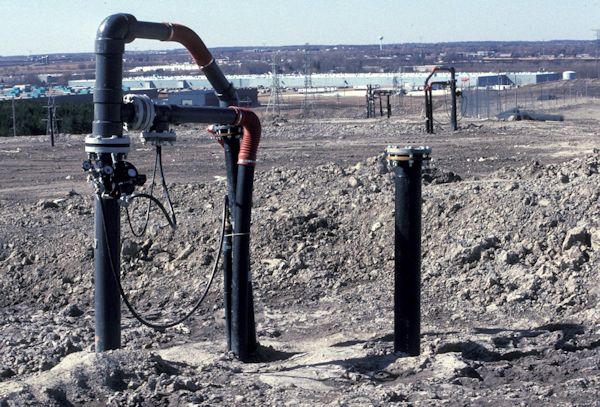SEJournal Online is the digital news magazine of the Society of Environmental Journalists. Learn more about SEJournal Online, including submission, subscription and advertising information.
 |
| Landfill gas extraction at a municipal solid waste facility in Wisconsin. An Obama-era rule to limit methane emissions had been delayed under the Trump administration, until a federal court ruling May 6. Photo: Wisconsin Department of Natural Resources. Click to enlarge. |
TipSheet: Is Your Local Landfill Leaking Methane?
Few people, except those with a truckload of trash, ever venture onto the premises of a municipal landfill, waste transfer station or waste management facility. But environmental journalists do. It’s just that they don’t go to dump trash. They go to observe and ask questions.
So which questions are of public concern about your landfill? Here’s one: The fate of its landfill gas. And now a recent ruling by a federal judge has the controversy over landfill gas back into the news cycle.
Why it matters
When organic materials like food waste and paper decompose in a landfill, they produce gasses that are (very roughly) half methane and half carbon dioxide. Uncontrolled, this gas seeps out of the landfill over time.
The problem? Both methane and carbon dioxide are greenhouse gasses that contribute to global warming. Landfill gas is the third largest source of methane emitted in the United States (after natural gas production and gassy cows). And methane has 21 times the warming impact of CO2.
The good news is that because landfills are somewhat contained, much of the gas can often be captured in pipes as it rises from deposited waste. It can then be flared, or further treated to separate gasses and to upgrade the methane to the quality usable for power generation (may require subscription) of a public gas utility.
It’s not just global warming gasses that are the problem though. Sometimes toxic materials in landfills emit toxic gasses as they degrade. So capturing and treating landfill gas can also lower the risks such toxic gasses present to the surrounding community.
The backstory
In its efforts to get a grip on climate change, the Obama EPA issued a rule, finalized in August 2016, to limit emissions of methane from some municipal landfills.
But the Trump EPA put that rule on hold soon after coming into office, in May 2017. Some parts of the waste management industry had opposed the rule, complaining about costs.
Lawsuits followed. Then, after an initial stay against the hold, EPA went on to stretch out the timeline for implementing the rule to two years or more.
The most recent development came May 6, when a federal district judge in California ruled that EPA could not delay enforcement of the Obama-era rule. EPA’s delay had been challenged by California and a coalition of seven other states that wanted the rule to go into effect. The states include Illinois, Maryland, New Mexico, Oregon, Rhode Island, Vermont and Pennsylvania.
Those states argued that delay of the rule perpetuates environmental harm caused by landfill emissions. Environmental groups such as the Natural Resources Defense Council supported the lawsuit.
It is not yet clear whether EPA will appeal the court decision or attempt further rulemaking. But the current rule requires states to come up with plans (many have not yet done so), so full roll-out would take years in any case.
Under the EPA rule, not every municipal landfill will have to capture methane. The rule applies mostly to newer or larger landfills.
Story ideas
- How big is your landfill? How new? Would EPA landfill gas regulations apply to it?
- How much methane or landfill gas is your landfill estimated to produce or emit?
- Is the gas from your landfill collected? How is it processed? What happens to it?
- What do your local landfill managers think of the pending EPA regulation?
- What is the position of your state solid waste management agency on the pending EPA regulation?
Reporting resources
- Your municipal solid waste agency, whether town, city or county, is responsible for trash pickup and disposal.
- U.S. Environmental Protection Agency runs (or doesn’t) the methane rule. But instead of the less-than-helpful HQ press office, try the regional press office or the landfill methane outreach program. The outreach page has an interactive map that helps find many of the landfill gas energy projects in the United States.
- Waste Dive is an online, un-paywalled publication covering municipal solid waste among other issues.
- Any companies that contract with your local municipal landfill to manage waste.
- Municipal Waste Management Association is a spinoff of the U.S. Conference of Mayors.
- Association of State and Territorial Solid Waste Management Officials is an organization of the people who run the state programs.
- National Waste & Recycling Association is a relevant trade group.
- Solid Waste Association of North America is another relevant trade group.
- Natural Resources Defense Council is an environmental group that has litigated on the EPA rule.
* From the weekly news magazine SEJournal Online, Vol. 4, No. 20. Content from each new issue of SEJournal Online is available to the public via the SEJournal Online main page. Subscribe to the e-newsletter here. And see past issues of the SEJournal archived here.














 Advertisement
Advertisement 



